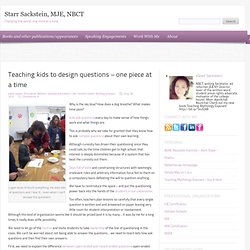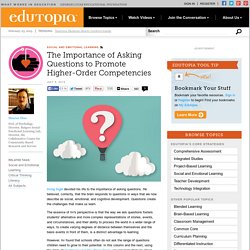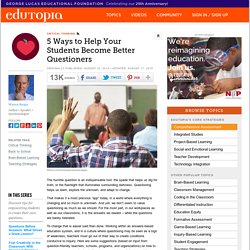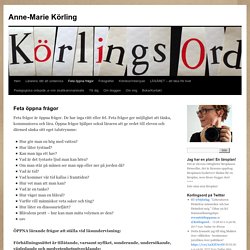

Relief Teaching IdeasWhat is the Question? - Relief Teaching Ideas. Fragandets_betydelse_lindberg_g_pdf_84493.pdf. Öppna frågor. Frågebatteri - Google Docs. BFL frågebatteri. Frågebatteri, av Jenny Ottosson, inspirerad av Marie Andersson, Ö-pedagogen. Teaching kids to design questions – one piece at a time. Logan loves to touch everything.

He asks lots of questions and I love it… even when I can’t answer the questions. Why is the sky blue? How does a dog breathe? What makes time pass? Kids ask questions every day to make sense of how things work and what things are. This is probably why we take for granted that they know how to ask complex questions about their own learning. Although curiosity has driven their questioning since they could talk, by the time children get to high school, that interest is deeply diminished because of a system that has beat the curiosity out them. Days full of bells and constraining structures with seemingly irrelevant rules and arbitrary information force fed to them on a compulsory basis defeating the will to question anything.
We have to reintroduce the spark – and put the questioning power back into the hands of the students in our classrooms. We need to let go of the control and invite students to take ownership of the line of questioning in the class. The Importance of Asking Questions to Promote Higher-Order Competencies. Irving Sigel devoted his life to the importance of asking questions.

He believed, correctly, that the brain responds to questions in ways that we now describe as social, emotional, and cognitive development. Questions create the challenges that make us learn. The essence of Irv's perspective is that the way we ask questions fosters students' alternative and more complex representations of stories, events, and circumstances, and their ability to process the world in a wider range of ways, to create varying degrees of distance between themselves and the basis events in front of them, is a distinct advantage to learning.
However, Irv found that schools often do not ask the range of questions children need to grow to their potential. In this column and the next, using the story of Goldilocks and The Three Bears, we can learn from Irv about how to improve our question asking so that students learn more from text and from the world around them. 5 Powerful Questions Teachers Can Ask Students. My first year teaching a literacy coach came to observe my classroom.

After the students left, she commented on how I asked the whole class a question, would wait just a few seconds, and then answer it myself. "It's cute," she added. Um, I don't think she thought it was so cute. I think she was treading lightly on the ever-so shaky ego of a brand-new teacher while still giving me some very necessary feedback. So that day, I learned about wait/think time. Many would agree that for inquiry to be alive and well in a classroom that, amongst other things, the teacher needs to be expert at asking strategic questions, and not only asking well-designed ones, but ones that will also lead students to questions of their own.
Keeping It Simple I also learned over the years that asking straightforward, simply-worded questions can be just as effective as those intricate ones. . #1. This question interrupts us from telling too much. . #2. . #3. . #4. 5 Ways to Help Your Students Become Better Questioners. The humble question is an indispensable tool: the spade that helps us dig for truth, or the flashlight that illuminates surrounding darkness.

Questioning helps us learn, explore the unknown, and adapt to change. That makes it a most precious “app” today, in a world where everything is changing and so much is unknown. And yet, we don’t seem to value questioning as much as we should. For the most part, in our workplaces as well as our classrooms, it is the answers we reward -- while the questions are barely tolerated. To change that is easier said than done. Läsa mellan raderna (Svenska) - Mellanstadiet. Feta öppna frågor. Feta frågor är öppna frågor.

De har inga rätt eller fel. Feta frågor ger möjlighet att tänka, kommunicera och lära. Öppna frågor hjälper också läraren att ge ordet till eleven och därmed sänka sitt eget talutrymme: Hur gör man en hög med vatten? Hur låter tystnad? ÖPPNA lärande frågor att ställa vid läsundervisning: Förhållningssättet är tillåtande, varsamt nyfiket, sonderande, undersökande, vägledande och medvetenhetsutvecklande: Vilket ord är det längsta? Då eleven kan läsa ord som du som lärare förvånas över kan läraren ställa dessa frågor.
Frågorna har till uppgift att medvetandegöra eleven och faktiskt också läraren: Hur gör du för att lösa läsningen av vissa ord Du lyckades att utläsa – brandbilsslang… Hur gjorde du?